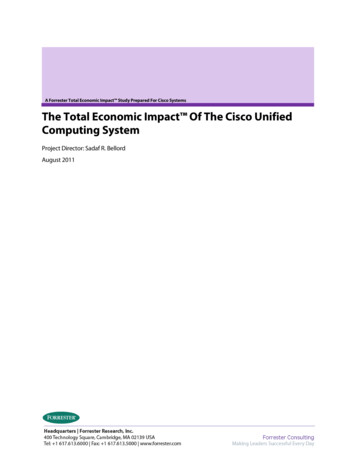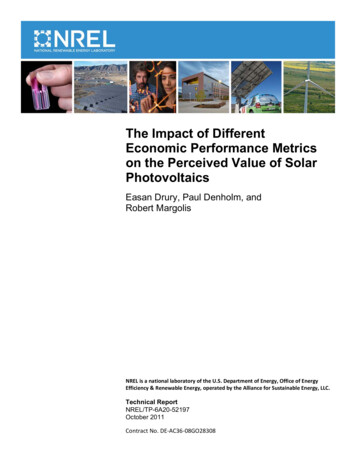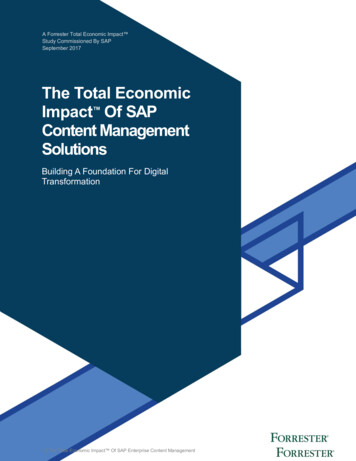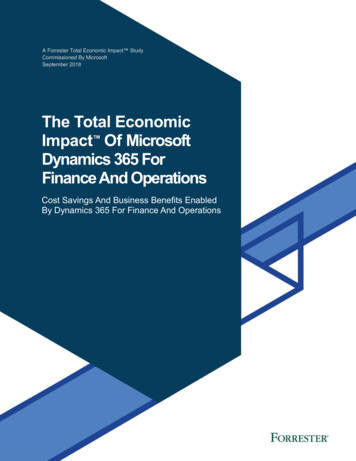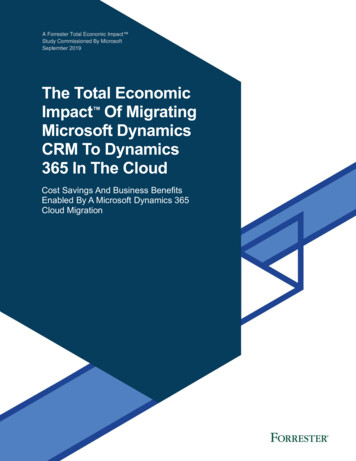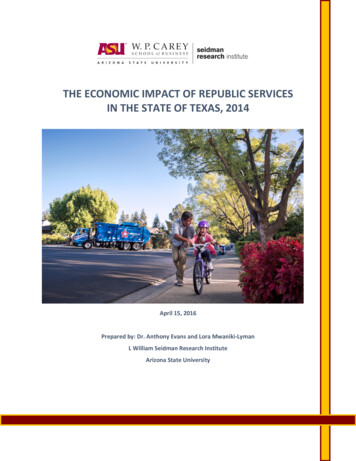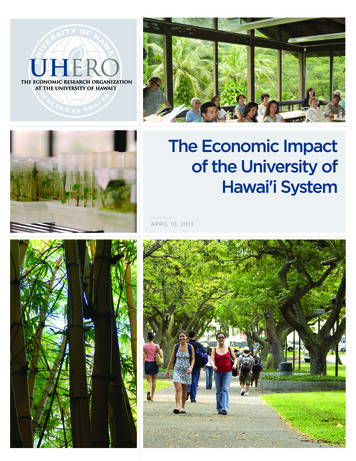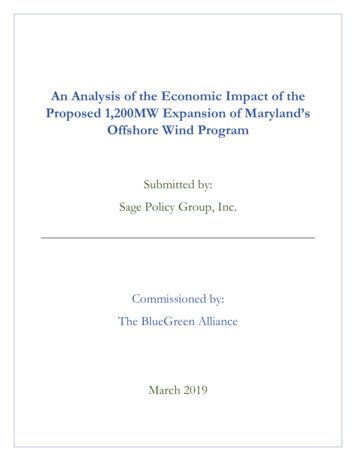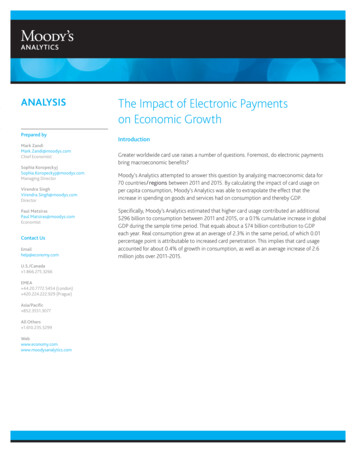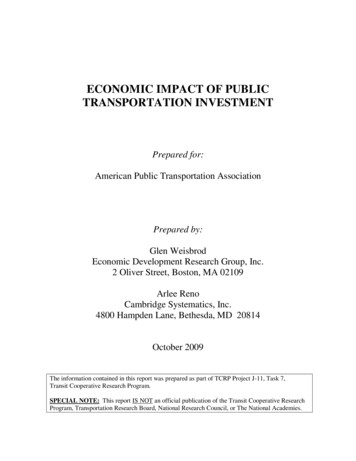
Transcription
ECONOMIC IMPACT OF PUBLICTRANSPORTATION INVESTMENTPrepared for:American Public Transportation AssociationPrepared by:Glen WeisbrodEconomic Development Research Group, Inc.2 Oliver Street, Boston, MA 02109Arlee RenoCambridge Systematics, Inc.4800 Hampden Lane, Bethesda, MD 20814October 2009The information contained in this report was prepared as part of TCRP Project J-11, Task 7,Transit Cooperative Research Program.SPECIAL NOTE: This report IS NOT an official publication of the Transit Cooperative ResearchProgram, Transportation Research Board, National Research Council, or The National Academies.
AcknowledgementsThis study was conducted for the American Public Transportation Association, with fundingprovided through the Transit Cooperative Research Program (TCRP) Project J-11, QuickResponse Research on Long-Term Strategic Issues. The TCRP is sponsored by the FederalTransit Administration; directed by the Transit Development Corporation, the education andresearch arm of the American Public Transportation Association; and administered by TheNational Academies, through the Transportation Research Board. Project J-11 is intended to fundquick response studies on behalf of the TCRP Oversight and Project Selection (TOPS)Committee, the Federal Transit Administration, and the American Public TransportationAssociation and its committees. The report was prepared by Glen Weisbrod of EconomicDevelopment Research Group, Inc. and Arlee Reno of Cambridge Systematics, Inc. The workwas guided by a technical working group. The project was managed by Dianne S. Schwager,TCRP Senior Program Officer.DisclaimerThe opinions and conclusions expressed or implied are those of the research agency thatperformed the research and are not necessarily those of the Transportation Research Board or itssponsoring agencies. This report has not been reviewed or accepted by the TransportationResearch Board Executive Committee or the Governing Board of the National Research Council.
Table of ContentsTable of ContentsSummary .i1. Introduction: Why Measure Economic Impacts?.51.1 Overview .51.2 Motivations for Economic Impact Analysis .61.3 Building on Prior Research.72. Methods: Literature and Findings .92.1 Spending Impacts .92.2 Travel Improvement Impacts.122.3 Access Improvement Impacts.182.4 Non-Monetary Impacts.222.5 Other Economic Impact Measures .233. Spending Impact .253.1 Direct, Indirect and Induced Effects .253.2 Mix of Capital and Operations Investment.263.3 Economic Impact Models .283.4 Overall Economic Impact of Spending .293.5 Types of Jobs: Impacts by Industry and Occupation .334. Cost Savings & Productivity Impacts.384.1 Public Transportation Capacity.394.2 Cost of Additional Ridership .434.3 Public Transport Use and Mode Switching .444.4 Passenger Cost Savings .454.5 Additional Congestion Reduction Benefit.494.6 Business Productivity Impact .524.7 Overall Economic Impact of Cost and Productivity Changes .545. Calculation & Updating Process.605.1 Need for Updating.605.2 Future Research Needs .61Appendix: Definition of Economic Impact.62A.1 Clarifying Economic Impact Analysis vs. Benefit-Cost Analysis .62A.2 Generators of Economic Impacts .64A.3 Direct, Indirect & Induced Economic Impacts .66Bibliography.68TCRP J-11 (7) - Economic Impact of Public Transportation Investment
SummarySUMMARYEconomic Impact of Public Transportation InvestmentTransit Cooperative Research Program (TCRP) Project J-11, Task 7by Economic Development Research Group and Cambridge SystematicsOctober 2009.Objective. Public transportation services are important in many ways. Theyprovide mobility, can shape land use and development patterns, generate jobs andenable economic growth, and support public policies regarding energy use, airquality and carbon emissions. All of these characteristics can be important whenconsidering the benefits, costs and optimal investment levels for publictransportation. This report focuses solely on just one aspect – how investment inpublic transportation affects the economy in terms of employment, wages andbusiness income. It specifically addresses the issue of how various aspects of theeconomy are affected by decisions made regarding investment in publictransportation.This report updates an earlier report -- Public Transportation and the Nation’sEconomy: A Quantitative Analysis of Public Transportation’s Economic Impact,prepared by Cambridge Systematics, Inc. and Economic Development ResearchGroup, for the American Public Transportation Association, 1999.Key findings of the report are organized in terms of three categories: (1) the effectof spending money on public transportation, which creates immediate jobs andincome by supporting manufacturing, construction and public transportationoperation activities; (2) longer-term effects of investment in public transportation,which enables a variety of economic efficiency and productivity impacts to unfoldas a consequence of changes in travel times, costs and access factors; and (3)conclusions regarding the interpretation and policy consideration of economicimpacts associated with public transportation investment.Key Findings on Public Transportation Spending ImpactsCapital investment in public transportation (including purchases of vehicles andequipment, and the development of infrastructure and supporting facilities) is asignificant source of jobs in the United States. The analysis indicates that nearly24,000 jobs are supported for a year, per billion dollars of spending on publictransportation capital.Public transportation operations (i.e., management, operations and maintenanceof vehicles and facilities) is also a significant source of jobs. The analysisTCRP J-11 (7) - Economic Impact of Public Transportation Investmenti
Summaryindicates that over 41,000 jobs are supported for a year, for each billion dollars ofannual spending on public transportation operations.Combining investment in public transportation capital and operations within theUS, the analysis indicates that an average of 36,000 jobs are supported for oneyear, per billion dollars of annual spending on public transportation, given theexisting mix of operations (71 percent) and capital (29 percent) expenditures.These investment impacts include directly supported jobs at manufacturers and atoperators of public transportation equipment and facilities, plus additional“indirect” jobs supported by orders for other product and service providers, and“indirect” jobs supported by consumer spending of workers’ wages. Theseoverall impacts can represent new jobs insofar as there is an increase in publictransportation spending and a sufficient number of unemployed persons to fillthese jobs (so that other pre-existing jobs are not displaced).Inflation changes the number of jobs supported per 1 billion of spending onpublic transportation. Consequently, over time, more dollars are needed toaccomplish the same public transportation investment.Other economic impacts are associated with the job impacts. Corresponding to the36,000 jobs is approximately 3.6 billion of added business output (sales volume),which provides 1.8 billion of GDP (gross domestic product, or “value added”) -including 1.6 billion of worker income and 0.2 billion of corporate income.This additional economic activity generates nearly 500 million in federal, stateand local tax revenues. [Note: these figures should not be added or otherwisecombined, because a portion of the business output provides the worker incomeand other elements of GDP, which in turn are sources for tax revenues.]Summary of the Short-term Economic Impact per Billion Dollars of NationalInvestment in Public Transportation (includes indirect and induced effects)APer Billionof CapitalEconomic ImpactSpendingJobs (Employment. thousands)23.8Output (Business Sales, billions) 3.0GDP (Value Added, billions) 1.5Labor Income ( billions) 1.1Tax Revenue ( millions, rounded) 350Per Billionof OperationsSpending41.1 3.8 2.0 1.8 530Per Billionof AverageSpendingB36.1 3.6 1.8 1.6 490A indirect and induced effects include impacts on additional industries; they provide multiplierimpacts on job creation only to the extent that there is sufficient unemployment to absorbadditional jobs without displacement of other existing jobs.B The US average impact reflects a mix of 29% capital and 71% operations spending. The studyfinds that the FTA federal aid impact is 30,000 jobs per billion of spending, due to a mix of 69%capital and 31% maintenance (operations). See full report for further explanation.TCRP J-11 (7) - Economic Impact of Public Transportation Investmentii
SummaryKey Findings on Public Transportation Productivity ImpactsInvestment in public transportation expands service and improves mobility, and, ifsustained over time, can potentially affect the economy by providing: travel and vehicle ownership cost savings for public transportationpassengers and those switching from automobiles, leading to shifts inconsumer spending; reduced traffic congestion for those traveling by automobile and truck,leading to further direct travel cost savings for businesses and households; business operating cost savings associated with worker wage and reliabilityeffects of reduced congestion; business productivity gained from access to broader labor markets withmore diverse skills, enabled by reduced traffic congestion and expandedtransit service areas; and additional regional business growth enabled by indirect impacts of businessgrowth on supplies and induced impacts on spending of worker wages. At anational level, cost savings and other productivity impacts can affectcompetitiveness in international markets.This report presents a methodology for calculating such impacts. To illustrate themagnitude of potential impacts, two alternative scenarios are outlined for longterm US public transportation investment; a “base case” scenario that maintainslong-term public transportation ridership trends, and a “higher transit investment”scenario that adds investment each year over the 2010-2030 period. The analysisestimates how travel times and costs, including effects of changes in congestionlevels and mode switching, differs among the scenarios.The results show that, per 1 billion of annual investment, public transportationinvestment over time can lead to more than 1.7 billion of net annual additionalGDP due to cost savings. This is in addition to the 1.8 billion of GDP supportedby the pattern of public transportation spending. Thus, the total impact can be 3.5 billion of GDP generated per year per 1 billion of investment in publictransportation.Potential Long-term Economic Impact per Billion Dollars of SustainedNational Investment in Public Transportation (Annual Effect in the 20th Year)Economic ImpactEffect of SpendingEffect of Transportation ChangesTotalGDP(Value Added) 1.8 billion 1.7 billion 3.5 billionTCRP J-11 (7) - Economic Impact of Public Transportation Investmentiii
SummaryThis analysis represents the scale of potential impacts on the economy and notbenefit/cost ratios. Specifically, economic impact studies do not account for someof the social and environmental impacts that are included in benefit/cost studies,though they do account for indirect and induced economic growth that istypically not included in benefit/cost studies.The social and environmental impacts that are not counted within the GDPimpact measure include, most notably, personal time savings and emissionsimpacts. The inclusion of these additional benefits would generate a largermeasure of total societal benefit per billion dollars of public transportationinvestment. However, they were not analyzed because this report focusesspecifically on how public transportation spending and investment affect theeconomy.ConclusionThe analysis shows that public transportation investment can have significantimpacts on the economy, and thus represent an important public policyconsideration. However, economic impacts should not be equated with the valueof total societal benefits associated with public transportation investment. Careshould also be taken to recognize the short-term effect of public transportationspending as well as the longer-term benefits of sustained transportationinvestment on travel times, costs and economic productivity. Both may be usefulconsiderations for public information and investment decisions.TCRP J-11 (7) - Economic Impact of Public Transportation Investmentiv
Chapter 1. Introduction1INTRODUCTION: WHY MEASUREECONOMIC IMPACTS?1.1.1 OverviewThis report discusses the nature of investment in public transportation capitalinvestments and operations in the United States, the ways in which thatinvestment affects the economy, and the additional impacts of publictransportation investments and services on economic growth in the United States.This topic has been examined in a series of past reports, including a widelycirculated APTA report published ten years ago (Public Transportation and theNation’s Economy: A Quantitative Analysis of Public Transportation’s EconomicImpact, Cambridge Systematics and Economic Development Research Group,1999). However, the nature of public transportation investment changes overtime, the structure of the economy continues to evolve and the analysis methodscontinue to improve. Consequently, the findings of this study differ from those ofearlier works, both in perspective and results.This report is organized into five parts.1. Introduction - examines the objectives of economic impact analysis andcompares these objectives to the broader objectives of public transportationcapital investment and spending on operations.2. Methods - presents a framework for classifying and viewing the key forms ofeconomic impact, and summarizes the important findings from past researchon this topic.3. Spending Impact - presents a methodology and analysis of the economicimpacts on money flowing through the economy as a consequence publictransportation capital and operations spending.4. Cost Savings and Productivity Impact - presents a methodology and analysisof the economic growth that result from the availability of publictransportation services.5. Updating - discusses the process for updating economic impact figures, andneeds for further research to improve future studies of this topic.There is also an Appendix that discusses the difference between economicimpact analysis (which is the focus of this report) and benefit-cost analysis(which considers a very different set of impacts). It is followed by aBibliography of sources cited.TCRP J-11 (7) - Economic Impact of Public Transportation Investment5
Chapter 1. Introduction1.2 Motivations for Economic Impact AnalysisTransportation investment affects the economy through two fundamentalmechanisms: (1) impacts of spending -- the act of investing money in publictransportation facilities and operations supports jobs and income for that industry,as well as jobs and income in supplier industries and other affected elements ofthe economy; (2) costs and productivity impacts – the public transportationservices that are enabled by that investment provide enhanced mobility, time andcost savings; leading to broader economic growth occurs as a result of changes indisposable household income, business productivity and market access.There are public policy interests in both elements of economic impact, as they canhelp address a variety of issues including:Flow of Impacts. Where does the money go? Who ultimately receives theadded income, the reduced costs or the other benefits from capital investmentsand operations?Breadth of Impacts. Do the money benefits (in the form of added income orreduced cost) end up going to a narrow set or to a broad set of businesses andhouseholds?Economic Stimulus and Competitiveness. Do the capital investment andoperations funds stimulate job and income growth where needed most (foreither short-term economic stimulus or longer-term economic competitiveness)?Consistency with Broad Public Policy. Do the capital investments andoperations activity complement or undermine other public investments? (interms of efforts to add higher-paying jobs, support economic diversification,attract target industries and invest in target areas).Complementing Benefit-Cost Analysis. To what extent are there economicimpacts related to mobility, access, and job preservation that are not otherwiserecognized in benefit/cost analysis?Difference between economic impact and benefit-cost analysis. It is importantto note that economic impact analysis is not the same as benefit-cost analysis.Economic impact analysis focuses specifically on measurable changes in the flowof money (income) going to households and businesses, including both spendingand productivity effects. That is different from benefit-cost analysis, whichconsiders the valuation of both money and non-money benefits including social,environmental and quality of life impacts. A more detailed discussion ofdifferences between economic impact analysis and benefit-cost analysis isprovided in the Appendix.TCRP J-11 (7) - Economic Impact of Public Transportation Investment6
Chapter 1. Introduction1.3 Building on Prior ResearchIn 1984 the American Public Transportation Association (APTA) conducted alandmark study of the employment and business revenue impacts of investment inpublic transportation. That study was updated in 1999 and this present studyseeks to further update and expand on topics covered by those previous studies.The key reports on this topic, conducted over the period of 1996-2008, are listedbelow and full citations for them are provided in the Chapter 5 bibliography.Key Research Studies on the Economic Impacts of Public Transportation APTA. Public Transportation and the Nation’
Group, for the American Public Transportation Association, 1999. Key findings of the report are organized in terms of three categories: (1) the effect of spending money on public transportation, which creates immediate jobs and income by support
